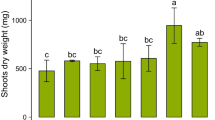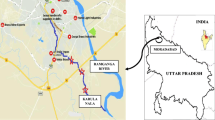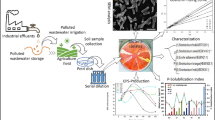Abstract
Rhizosphere microorganisms harboring nickel hyperaccumulators, Rinorea bengalensis (Wall.) O. K. and Dichapetalum gelonioides ssp. andamanicum (King) Leenh. endemic to serpentine outcrops of Andaman Islands, India, were screened for their tolerance and accumulation of Ni. The rhizosphere soils from both the plants were rich in total and available Ni along with Co, Cr, Fe and Mg but poor in microbial density and were dominated by bacteria. Out of total 123 rhizosphere microorganisms (99 bacteria and 24 fungi), bacteria were more tolerant to Ni than fungi. Viable cells of selected Ni-tolerant bacterial isolates (MIC = 13.6–28.9 mM Ni) belonging to Pseudomonas, Bacillus and Cupriavidus were capable of accumulating nickel (209.5–224.0 μM Ni g−1 protein) from aqueous solution. Cupriavidus pauculus KPS 201 (MTCC 6280), showing highest degree of nickel tolerance (MIC 28.9 mM Ni) and uptake (224.0 μM Ni g−1 protein, 60 min) was used for detailed study. Kinetics of nickel uptake in C. pauculus KPS 201 followed a linearized Lineweaver-Burk plot. The K m and V max for nickel uptake by minimal medium grown-cells approximated 1.5 mM Ni and 636.9 μM Ni g−1 protein, respectively. The uptake process was inhibited by Co, Cu, Cd, Mg, Mn and Zn, however, complete inhibition was not achieved even in presence of 500 mM Mg. Metabolic inhibitors, sodium azide (1.0 mM) and carbonyl cyanide m-chlorophenylhydrazone (0.4 mM) strongly inhibited nickel uptake suggesting the process as an energy dependent one. The present study clearly shows that bacteria in the rhizosphere of Ni-hyperaccumulators are capable of tolerating high concentration of Ni and also possesses nickel uptake potential. The Ni-hyperaccumulators in combination with these Ni-resistant bacteria could be an ideal tool for nickel bioremediation.



Similar content being viewed by others

Abbreviations
- MIC:
-
Minimum Inhibitory Concentration
- HEPES:
-
N-[2–Hydroxyethyl] Piperazine-N′-[2-ethanesulphonic acid]
References
Abou-Shanab RA, Angle JS, Delorme TA, Chaney RL, van Berkum P, Moawad H, Ghanem K, Ghozlan HA (2003) Rhizobacterial effects on nickel extraction from soil and uptake by Alyssum murale. New Phytol 158:219–224
American Public Health Association APHA (1998) Standard methods for the examination of waters and wastewater. American Public Health Association, Washington DC
Baker AJM, Brooks RR (1989) Terrestrial higher plants which accumulate metallic elements: a review of their distribution, ecology and phytochemistry. Biorecovery 1:81–126
Baker AJM, McGrath SP, Reeves RD, Smith JAC (2000) Metal hyperaccumulator plants: a review of the ecology and physiology of a biological resource for phytoremediation of metal-polluted soils. In: Terry N, Banuelos E (eds) Phytoremediation of contaminated soil and water. Lewis Publ, London UK, pp. 85–107
Baker AJM, Procter J, van Balgooy MMJ, Reeves RD (1992) Hyperaccumulation of nickel by the flora of the ultramafics of Palawan, Republic of Philippines. In: Baker AJM, Procter J, Reeves RD (eds) The vegetation of ultramafic soils: Proceedings of the first International Conference on Serpentine Ecology, pp. 291–304 Intercept Ltd., Andover, Hampshire, UK
Beveridge TJ, Doyle R (1989) Metal ions and bacteria. Wiley, New York
Blanco A, Sanz B, Llama MJ, Serra JL (1999) Biosorption of heavy metals to immobilized Phormidium laminosum biomass. J Biotechnol 69:227–240
Bordons A, Jofre J (1987) Nickel accumulation by bacteria. Environ Technol Lett 8:495–500
Brooks RR, Wither ED (1977) Nickel hyperaccumulation by Rinorea bengalensis (Wall.) O. K. J Geochem Explor 7:295–300
Bryson MF, Drake HL (1988) Energy-dependent transport of nickel by Clostridium pasteurianum. J Bacteriol 170:234–238
Calomiris JJ, Armstrong TL, Seidler RJ (1984) Association of metal-tolerance with multiple antibiotic resistance of bacteria isolated from drinking water. Appl Environ Microbiol 47:1238–1242
Ghozlan HA, Sabry SA, Amer RA (1999) Bioaccumulation of nickel, cobalt and zinc by free and immobilized cells of Pseudomonas spp. Fresenius Environ Bull 8:428–435
Gilman JC (1957) A manual of soil fungi. The Iowa State College Press, Iowa, USA
Halder D (1984) Some aspects of the Andaman ophiolite complex. Records Geol Survey India 115:1–11
Holt JG, Kreig NR, Sneath PHA, Staley JT, Williams ST (1994) Bergey’s manual of determinative bacteriology. Willams and Wilkins, Baltimore, USA
Hughes MN, Poole RK (1989) Metals and microorganisms. Chapman and Hall, New York
Hughes JC, Noble AD (1991) Extraction of chromium, nickel and iron and the availability of chromium and nickel to plants from some serpentine derived soils from the eastern Transvaal as revealed by various single and sequential extraction techniques. Commun Soil Sci Plant Anal 22:1753–1766
Idris R, Trifonova R, Puschenreiter M, Wenzel WW, Sessitsch A (2004) Bacterial communities associated with flowering plants of the Ni hyperaccumulator Thlaspi goesingense. Appl Environ Microbiol 70:2667–2677
Jackson ML (1973) Soil chemical analysis, vol. 14. Prentice Hall, New Delhi
Jafri SH, Charan SN, Govil PK (2003) Plagiogranite from the Andaman ophiolite belt, Bay of Bengal, India. J Geol Soc 152:681–688
Jarell KF, Sprott GD (1982) Nickel transport in Methanobacterium byrantii. J Bacteriol 151:1195–1203
Kruckeberg AR (1995) A semiquantitative test for nickel hyperaccumulation. Madrono 42:461
Laset MM (2002) Phytoextraction of toxic metals: a review of biological mechanisms. J Environ Qual 31:109–120
Lohmeyer M, Friedrich CG (1987) Nickel transport in Alcaligenes eutrophus. Arch Microbiol 149:130–135
Lombi E, Zaho FJ, Dunham SJ, McGrath SP (2000) Cadmium accumulations in populations of Thlaspi caerulescens and Thlaspi goesingense. New Phytol 145:11–20
Lowry OH, Rosebrough NJ, Farr AL (1951) Protein measurement with the folin-phenol reagent. J. Biol. Chem. 193:265–275
Magyarosy A, Laidlaw RD, Kilaas R, Echer C, Clark DS, Keasling JD (2002) Nickel accumulation and nickel oxalate precipitation by Aspergillus niger. Appl Microbiol Biotechnol 59:382–388
Mengoni A, Barzanti R, Gonnelli C, Gabbrielli R, Bazzicalupo M (2001) Characterization of nickel-resistant bacteria isolated from serpentine soil. Environ Microbiol 3:691–708
Mulrooney SB, Hausinger RP (2003) Nickel uptake and utilization by microorganisms. FEMS Microbiol Rev 27:239–261
Nies D, Silver S (1989) Metal ion uptake by plasmid-free metal sensitive Alcaligenes eutrophus strain. J Bacteriol 171:4073–4075
Pal A, Dutta S, Mukherjee PK, Paul AK (2005) Occurrence of metal resistance in serpentine microflora from Andaman Islands. J Basic Microbiol 45:207–218
Rubikas J, Matulis D, Leipus A, Urbaitiene D (1997) Nickel resistance in Escherichia coli V38 is dependent on the concentration used for induction. FEMS Microbiol Lett 155:193–198
Sar P, Kazy SK, Asthana RK, Singh SP (1998) Nickel uptake by Pseudomonas aeruginosa: Role of modifying factors. Curr Microbiol 37:306–311
Schlegel HG, Cosson JP, Baker AJM (1991) Nickel hyperaccumulating plants provide a niche for nickel resistant bacteria. Bot Acta 104:18–25
Singh K, Kumar A (1998) Incidence of multiple metal resistance in a Bacillus species. J. Microbiol. Biotechnol. 8:497–500
Stoppel RD, Schlegel HG (1995) Nickel resistant bacteria from anthropogenically nickel polluted and naturally nickel percolated ecosystems. Appl Environ Microbiol 61:2276–2285
Stults L, Mallick S, Maier RJ (1987) Nickel uptake in Bradyrhizobium japonicum. J Bacteriol 169:1398–1402
Takakuwa S (1987) Nickel uptake in Rhodopseudomonas capsulata. Arch Microbiol 149:57–61
Vandamme P, Coenye T (2004) Taxonomy of the genus Cupriavidus: a tale of lost and found. Int J Syst Evol Microbiol 54:2285–2289
Vandamme P, Goris J, Coenye T, Hoste B, Janssens D, Kersters K, De Vos P, Falsen E (1999) Assignment of Centers of Disease Control group IVc-2 to the genus Ralstonia as Ralstonia paucula sp. nov. Int J Syst Bacteriol 49:663–669
Watt RK, Luden PW (1999) Ni2+ transport and accumulation in Rhodospirillum rubrum. J Bacteriol 181:4554–4560
Wauters G, Avesani V, Laffineur K, Charlier J, Janssens M, Van Bosterhaut B, Delmée M (2003) Brevibacterium lutescens sp. nov., from human and environmental samples. Int J Syst Evol Microbiol 53:1321–1325
Wenzel WW, Bunkowski M, Puschenreiter M, Horak O (2003) Rhizosphere characteristics of indigenously growing nickel hyperaccumulator and excluder plants on serpentine soil. Environ Poll 123:131–138
Acknowledgements
The authors express appreciation to Ms. Veronique Avesani, Molecular Biology Section, Microbiology Laboratory, Universite Catholique de Louvain, Brussels, Belgium for expert technical assistance in 16S rDNA amplification and sequencing. Thanks are also due to Dr. S. SenRoy, Department of Statistics, University of Calcutta, Kolkata for assistance in statistical analysis. Financial support to one of us (A. Pal) from Ministry of Environment and Forest, Government of India, New Delhi, India is duly acknowledged.
Author information
Authors and Affiliations
Corresponding author
Rights and permissions
About this article
Cite this article
Pal, A., Wauters, G. & Paul, A.K. Nickel tolerance and accumulation by bacteria from rhizosphere of nickel hyperaccumulators in serpentine soil ecosystem of Andaman, India. Plant Soil 293, 37–48 (2007). https://doi.org/10.1007/s11104-007-9195-7
Received:
Accepted:
Published:
Issue Date:
DOI: https://doi.org/10.1007/s11104-007-9195-7



